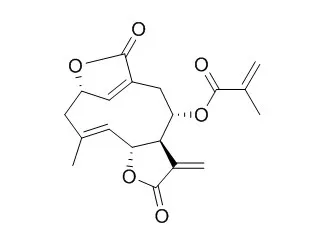| In vitro: |
| Chin Med. 2014 Apr 17;9:14. | | Isodeoxyelephantopin from Elephantopus scaber (Didancao) induces cell cycle arrest and caspase-3-mediated apoptosis in breast carcinoma T47D cells and lung carcinoma A549 cells.[Pubmed: 24742378] |
METHODS AND RESULTS:
Isodeoxyelephantopin (IDOE) isolated from Elephantopus scaber L. (Didancao) is used in Chinese medicine for the treatment of some types of cancer. The anti-cancer mechanism of Isodeoxyelephantopin remains unclear. This study aims to investigate the antiproliferative activity of Isodeoxyelephantopin on breast carcinoma T47D cells and lung carcinoma A549 cells. Isodeoxyelephantopininhibited the growth of A549 and T47D cells in a dose- and time-dependent manner with IC50 values of 10.46 and 1.3 μg/mL, respectively. Isodeoxyelephantopin was not significantly toxic to normal lymphocytes. The cells became detached from the monolayer and rounded up, had fragmented nuclei and condensed chromatin, and the numbers of apoptotic cells increased (P = 0.0003). Isodeoxyelephantopin-induced cell death was associated with activated caspase-3 expression followed by cell cycle arrest at G2/M phase.
CONCLUSIONS:
Isodeoxyelephantopin inhibited the proliferation of breast cancer cells and lung carcinoma cells and induced caspase-3-mediated apoptosis and cell cycle arrest in the treated cells. | | Clin Cancer Res. 2006 Oct 1;12(19):5910-8. | | Isodeoxyelephantopin, a novel sesquiterpene lactone, potentiates apoptosis, inhibits invasion, and abolishes osteoclastogenesis through suppression of nuclear factor-kappaB (nf-kappaB) activation and nf-kappaB-regulated gene expression.[Pubmed: 17021000] | Deoxyelephantopin (ESD) and Isodeoxyelephantopin (ESI) are two sesquiterpene lactones derived from the medicinal plant Elephantopus scaber Linn. We postulated that ESD and Isodeoxyelephantopin mediate their activities through modulation of the NF-kappaB activation pathway.
METHODS AND RESULTS:
We investigated the effect of Isodeoxyelephantopin and ESD on NF-kappaB activation by electrophoretic mobility shift assay and NF-kappaB-regulated gene expression by Western blot analysis. We found that Isodeoxyelephantopin suppressed NF-kappaB activation induced by a wide variety of inflammatory agents, including tumor necrosis factor (TNF), interleukin-1beta, phorbol 12-myristate 13-acetate, and lipopolysaccharide. Isodeoxyelephantopin did not interfere with the binding of NF-kappaB to DNA but rather inhibited IkappaBalpha kinase, IkappaBalpha phosphorylation, IkappaBalpha degradation, p65 phosphorylation, and subsequent p65 nuclear translocation. Isodeoxyelephantopin also suppressed the expression of TNF-induced NF-kappaB-regulated, proliferative, antiapoptotic, and metastatic gene products.
CONCLUSIONS:
Our results indicate that Isodeoxyelephantopin inhibits NF-kappaB activation and NF-kappaB-regulated gene expression, which may explain the ability of Isodeoxyelephantopin to enhance apoptosis and inhibit invasion and osteoclastogenesis. |
|






 Cell. 2018 Jan 11;172(1-2):249-261.e12. doi: 10.1016/j.cell.2017.12.019.IF=36.216(2019)
Cell. 2018 Jan 11;172(1-2):249-261.e12. doi: 10.1016/j.cell.2017.12.019.IF=36.216(2019) Cell Metab. 2020 Mar 3;31(3):534-548.e5. doi: 10.1016/j.cmet.2020.01.002.IF=22.415(2019)
Cell Metab. 2020 Mar 3;31(3):534-548.e5. doi: 10.1016/j.cmet.2020.01.002.IF=22.415(2019) Mol Cell. 2017 Nov 16;68(4):673-685.e6. doi: 10.1016/j.molcel.2017.10.022.IF=14.548(2019)
Mol Cell. 2017 Nov 16;68(4):673-685.e6. doi: 10.1016/j.molcel.2017.10.022.IF=14.548(2019)